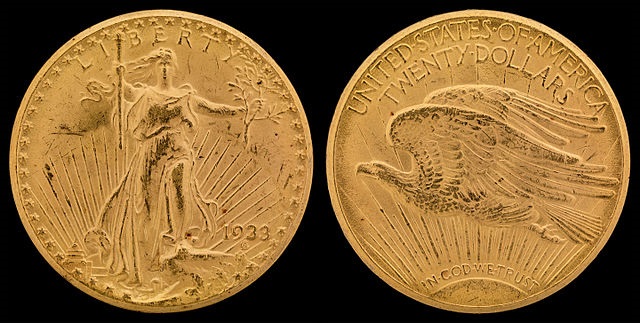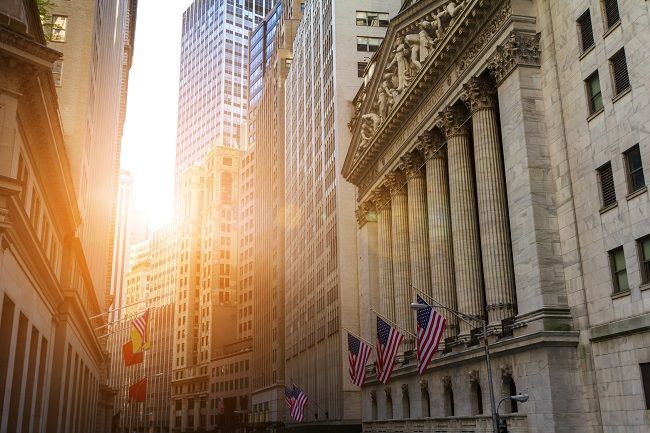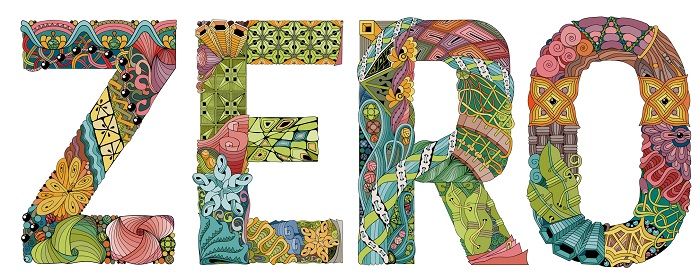The Unexpected Journey of the 1933 Saint- Gaudens Double Eagle
Posted on — Leave a commentIn late August of 2005 the US Mint seized ten 1933 Saint-Gaudens Double Eagle coins gold coins from a Philadelphia jeweler. Many consider the total value of the coins to be incalculable. They are among the rarest in the world.

The jeweler, Joan S. Langbord, immediately started a federal court lawsuit to recover the coins. At the same time, the acting director of the mint declared that Langbord, and her family, obtained the coins “in an unlawful manner.”
The story of Langbord and how her family came into possession of the coins dates back decades when they were first minted.
In the early 1930s the US was in the grip of a banking crisis. Banks started to fail as investment banking losses mounted. The problem worsened when panic set in causing bank runs in which vast numbers of account holders withdrew their funds simultaneously. As part of a solution, president Franklin D. Roosevelt issued an executive order. He demanded that citizens turnover any gold in their possession to the Federal Reserve bank.
Eventually, he passed the Gold Reserve Act in 1934 outlawing the circulation and private ownership of US gold coins. This new law meant that the recently struck 1933 Saint-Gauden Double Eagle coins were no longer legal tender. The mint melted the coins and reserved two for inclusion into the U.S. National Numismatic Collection. The US mint thought the Gold Reserve Act was the last chapter in the story of the Saint-Gaudens Double Eagle.
They were wrong.
Unknown to the mint, a number of these coins found their way into the hands of private collectors. In time, the Secret Service learned of the missing coins. They started an investigation. In the first year of their work agents recovered seven double eagle coins. Eventually, their investigation led them to an unexpected place: Egypt.
King Farouk of Egypt owned a double eagle coin. He purchased it in 1944 by applying to the US Treasury for an export license. The request was granted because at the time, the US mint was still unaware of the theft of the coins. The US attempt to recover the coin but World War II derailed efforts. Later, in 1952, Farouk fell from power after citizens staged a coup. Officials auction his possessions. The US requested the coin, and though the Egyptian government agreed, the piece mysteriously disappeared.
In 1996 law enforcement recovered the coin in a sting operation at New York’s Waldorf-Astoria Hotel. The coin was found with a British coin dealer who swore under testimony that the piece traced back to King Farouk. After its recovery US agents stored to coin in reserve vaults at the World Trade Center. Just two months before September 11th officials moved the coin to Fort Knox.
The fervor surrounding this particular coin kept agents on the lookout for more. Eventually they found what they were looking for in the hands of Joan S. Langbord. In the following years a series of trials resulted in the coins bouncing between the Langbord family and the US government. Today, they reside with the Federal government.
Some believe there are still original 1933 double eagle coins hiding in tin cans and basements. We’ll likely never know how many are out there. But, we do know they’re valuable. In 2002 an anonymous collector purchased one for $7.59 million.
Barron’s Cover Story: Why Gold Should Be Part of Your Portfolio
Posted on — Leave a commentIn case you missed it, Barron’s devoted its cover story to gold on September 21.

The title of the article: “Gold Is Cheap. Inflation Is Coming. You Do the Math.”
Kind of catchy, right?
The basic premise of the article is that gold has taken a hit this year (down about 8%), but more importantly – why gold deserves a spot in your portfolio.
The author, Andrew Bary, interviewed a number of portfolio managers and traders. Here is the key premise:
“Compared with stocks and other financial assets, gold looks inexpensive. More important, inflation is starting to pick up in the U.S. and in much of the world as central banks shrink their enormous balance sheets. And gold has represented a good defense against inflation eroding the value of a stock or bond portfolio. Over time, it has held its value against the dollar.”
There’s so many reasons to own gold and Bary hits on most of them in this article:
- Gold is cheap today. He compared an ounce of gold to the Dow Jones Industrial Average. Today it takes about 22 ounces of gold to buy one unit of the Dow. That compares to about 7.8 in 2011, when gold trades to its all-time high above $1,900.
- Gold is a traditional hedge against financial and economic crises. Most recently, after the collapse of Lehman Brothers in September 2008, gold rallied 17%. The S&P 500 fell 40%.
- Gold is rare and it’s difficult to quickly increase the supply of the precious metal. (Unlike a government printing press where the Fed can create trillions of dollars out of thin air.)
- Inflation is starting to pick up in advanced economies. Gold has long been a good defense against inflation erosion in dollar holdings.
While many U.S. investors currently own little or no gold, one of the biggest bulls out there is Jeffrey Gundlach, chief investment officer at DoubleLine Capital, a well-known bond market guru.
Gundlach has turned bullish on gold following the recent short-lived breach of the $1,200 per ounce level.
Here’s how the Barron’s reporter wraps up his conclusion:
“U.S. stocks are at record levels exactly at a time when global stress—trade tensions, populist nationalism, and the like—appears to be growing. This may be an opportune moment for investors to shift at least a portion of their portfolios to gold.”
There’s strengthening evidence that the 2018 low in gold has formed.
From cover story articles to major Wall Street gurus proclaiming themselves outright bullish on the market, the odds favor higher gold prices ahead.
Gold is the ultimate safe-haven asset. It’s only a matter of time before it spikes higher again.
Your Brain Likes Shortcuts, and That’s a Problem
Posted on — Leave a commentIn recent years, articles and videos promising “life hacks” have become popular. These tips and tricks are shortcuts for navigating life’s petty challenges and problems. We like these life hacks because our brain is wired to look for quick and easy solutions. We do so to conserve energy and cognition. At first glance it appears these shortcuts are a benefit which allow us to move fast and avoid overthinking. However, there is one problem:

These shortcuts unfold without our knowledge.
Behavioral economics has brought attention to these hidden influences. This branch of economics shows us how these approaches to problem solving, sometimes called “heuristics,” can undermine our goals. One prominent Duke University professor who has studied these heuristics and biases is Dan Ariely. In his experiments he has learned about a peculiar characteristic of human psychology, the “price placebo.”
The placebo effect is the phenomenon of taking a medication which, unknown to the patient, is artificial. Believing that the medication is in fact real, the patient feels better without having undergone any real medical treatment. Ariely’s insight was that this trickery also works with prices.
In his experiment, participants subjected themselves to small electrical shocks. Each delivered a painful sensation. Later, Ariely offered the participants a pain killer. If the subject wanted it, they would have to pay. Ariely’s price was $2.50. Nearly all who paid for the painkiller – nothing more than vitamin C – reported feeling better. At this point, all of the findings were predictable, after all, the placebo effect is a well-known phenomenon. Things changed, however, when Ariely altered the price.
Ariely started charging just $0.10 for the false painkiller. This time participants were much less receptive to the medication and remarked that is was ineffective. People really do believe that they get what they pay.
This finding has implications for equity investors today who are willing to pay much more than they have in the past. Perhaps the high stock prices of today have given way to a price placebo in which investors believe expensive stocks offer far more potential.
For example, since 2013, stock prices, as measured by their P/E ratios, have been in the highest quintile. This means that for five years stocks have been at the highest end of the “pricey” scale. Ariely’s research suggests that an expensive stock market has vaulted expectation to unrealistic levels. As Wall Street Journal columnist Jason Zweig recently explained, “Markets tend to lose their dominance right around the time it seems most irresistible.”
During this period of great expectations, gold has sat largely ignored. As more investors continue to flock to the stock market, gold has receded to much more affordable prices. These lower costs make it easier for incoming gold investors to realize a long-term profit because the cost doesn’t “price in” extraordinary expectations.
As Ariely explains, “Our irrational behaviors are neither random nor senseless- they are systematic and predictable. We all make the same types of mistakes over and over, because of the basic wiring of our brains.”
Ignore Cassandra’s Prophecy at Your Own Peril
Posted on — Leave a commentStudents of Greek mythology will recognize the tragedy that surrounds the words that Cassandra speaks.
Cassandra of Troy, was a daughter of King Priam and Queen Hecuba in Greek methodology. Attracted by her breathtaking beauty, Apollo gave her the power of prophecy and foretelling the future in an attempt to seduce her. Strong willed and defiant at times, Cassandra rejected Apollo. As the story goes, Apollo spat in her mouth triggering a curse that no one would ever believe her prophecies.

Sadly today, the yield curve (or the spread between the 10-year note and 3-month note yield) has become a modern day Cassandra.
An inversion of the yield curve is the best predictor of recession for the last 50 years. It has inverted before every single recession with no false positives.
An inverted yield curve means that the long-term Treasuries have a lower yield than short-term debt instruments.
Yet, economists and even Fed officials are questioning the predictive power of the yield curve.
They are falling into the dangerous trap of not listening to Cassandra. This has happened before.
In 2006, prior to the global financial crisis, the yield curve inverted. At that time, former Fed chairman Ben Bernanke argued the inverted yield curve may no longer be a strong recession indicator since bond markets have become global.
Well, the rest is history as the Great Recession soon followed.
Just as Apollo became lost in Cassandra’s beauty, Wall Street veterans have become entranced with the ever-growing U.S. economy. What could go wrong? Recession? No way, they say.
Don’t forget this juiced-up late stage expansion is fueled by one of the largest corporate tax cuts in history. The $1.8 trillion fiscal stimulus package passed last year is working. Here’s the rub. It only lasts so long. Congress can’t pass another tax cut next year and the economy will begin to run out of gas.
The yield curve hasn’t inverted yet. But, it is flattening noticeably. The 10-year note yield at 2.9% is still above the 3-month bill yield at 2.1%. But, it’s getting close.
As the Federal Reserve continues to hike interest rates, the inversion will become closer and closer.
This is a foolproof recession predictor.
In July 2000, the yield curve inverted. Not long after, the business cycle peaked, the Dot.Com stock market crash came and the recession started in March 2001. Then, the yield curve inverted in August 2006, and the Global Financial Crisis sparked a recession that began in December 2007. It has inverted before every recession back to 1953, when the data started.
It’s time to listen to Cassandra.
The yield curve is warning that the next recession is on the horizon, no matter how rosy the economy looks right now.
The S&P 500 lost roughly 50% of its value in the 2007-2009 bear market. Yes, 50%!
If you haven’t fully diversified your portfolio with tangible assets, the yield curve is warning that you should act now. Physical gold bullion typically surges sharply higher when stocks crash.
Owning physical gold is a simple strategy to protect your assets in the coming recession. Don’t make the mistake of discounting Cassandra’s warning. Ignore her at your own peril.
Life as a Legal Monopoly
Posted on — Leave a commentA central bank is a legal monopoly. What exactly does this mean? It means that a central bank is an institution that has the right to print money, whereas no other bank does. Therefore, the central bank controls the money supply. They set interest rates and act as an emergency lender. In the US, the central bank is the Federal Reserve. What does all of this mean for gold investors?

Central banks hold something called “Foreign Exchange Reserves.” These are assets held in a foreign currency. Central banks keep these foreign reserves on hand as an emergency measure. If the home currency fails, then at least the central bank will have this non-home currency to fall back on. These assets include foreign bonds, banknotes, government securities, and gold.
Recently, the International, Monetary Fund reported that gold represents approximately 10% of the total value of foreign exchange assets across the globe. Therefore, central banks are a key purchaser in the gold market. In fact, the World Gold Council reported that central banks represent 10% of total demand in the gold market.
Lately, they’ve been buying more.
In the first half of 2018, central banks bought 193 tons of gold. This total represents an 8% increase over purchases during the same period last year. Some of the biggest purchasers – representing 86% of the total – include Russia, Turkey, and Kazakhstan.
While the US economy is on solid ground for the moment, there are lingering geopolitical and economical concerns elsewhere. These conditions might be a factor in central banks’ decision to increase their gold holdings. As the World Gold Council explains, “Many emerging market central banks have a high degree of exposure to the US dollar and turn to gold as a natural currency hedge.”
More importantly, an increase in gold holdings by central banks makes intuitive sense. Why? Because these institutions need to have the flexibility to quickly liquidated positions if the global markets move a certain way. Gold allows this flexibility because it is a universal currency accepted in every country.
Though central banks are powerful and towering institutions, their strategy has relevance to everyday investors. Central banks buy gold because they want to be prepared for any scenario. Similarly, investors should consider the same approach.
For example, since 2013, stocks have exhibited high valuations. In fact, valuations in stocks today have never been higher with the exception of the 1999 dot com bubble.
High valuations should signal two things to investors. First, stocks might be overpriced, or nearing a point where they will soon be overpriced. Second, it suggests that the rapid growth seen in the stock market over the last 9+ years is nearing a point where it will have to come back to Earth. Liquidity is a key component to any portfolio safeguard. Gold offers this liquidity because dramatic drops in the stock and bond market are unlikely to precipitate similar drops in gold especially when central banks have such an appetite for the metal.
Take a page from the book of the biggest player on the field. Most will find that if gold is good enough for central banks, it’s good enough for them.
The Extreme Bullish Set-Up in Paper Gold Right Now
Posted on — Leave a commentWhen you stretch a rubber band too far, it snaps back in the other direction, hard and fast. That is an apt description for the paper gold market right now.

In the paper gold market, when speculators sell gold, they put on “short” positions at the COMEX, the primary futures metals exchange.
In the short run, these paper trade flows can drive commodity pricing.
In August, gold speculators switched from a bullish position to an extreme bearish position and the price of gold fell swiftly lower.
However, this is not a bear market situation. This is a bull market story in gold.
Speculators total short positions in gold on the Comex exchange is measured by the CFTC Commitment of Traders (COT) report.
This is a useful tool to gauge whether a trade is crowded or not and whether there is more flow to come or if the market is oversold.
In August, speculators short positions in Comex gold hit an extreme high reading.
What Does This Mean For Gold Prices?
Extreme speculative activity on the short side as measured by the COT report typically presages major bottoms. This suggests a bottom for gold prices could be close or already in.
Futures short-covering is often the first stage of a major bull market move in gold.
When speculators sell gold futures short, they don’t actually own gold or a gold futures contract. In order to exit their position, they need to buy a futures contract.
In futures trading that is called “Short-covering” or a “Short-Squeeze.”
When you stretch a rubber band too far it snaps back. The gold market is primed to snap back to sharply higher levels. There are a number of potential macro triggers out there and any one of them could start a short-covering rally.
If gold pops higher for any reason, these speculators will be forced to run for cover and will need to buy gold back so they don’t lose more money. As they buy back all these short positions accumulated over August it will drive the price of gold swiftly higher.
What Could Trigger A Short-Squeeze In Gold?
Here’s a brief look at a few factors that could send gold spiraling higher this fall.
- A Reversal In the U.S. Dollar
Gold typically trades in an inverse relationship to the dollar. As the U.S. dollar moves higher, typically gold moves lower. Last week, the Wells Fargo Investment Institute released a new report to its clients. They upgraded their outlook on commodities to favorable. One reason is the U.S. dollar.
“We expect the dollar to depreciate from current levels by year-end 2018 and through June 2019,” the WFII report said.
- A Sell-Off in Stocks
While October typically has a bad rap in the stock market, it turns out September has historically performed the worst. That’s good news for gold. A quick pullback or correction in the stock market would drive gold prices higher in safe-haven buying.
- The worst September ever for the S&P 500 was a 30% drop in 1931. In fact, no other month has had more 10% drops than September, at seven, according to LPL Financial.
“September is the banana peel month, as some of the largest slips tend to take place during this month. Although the economy is still quite strong, and stocks are marking hew highs, this doesn’t mean some usual September volatility is out of the question—in fact, we’d be surprised if volatility didn’t pick up given midterm years tend to see big moves in the months leading up to the November election,” said Ryan Detrick, senior market strategist at LPL Financial.
- Black Swan Event
By definition, a black swan event is one that no one sees coming. The 2008 Financial Crisis is a great example. Gold historically performs well during economic, political and military conflict. Any Black Swan event would likely send gold spiraling higher.
Add Physical Gold to Your Portfolio
If you haven’t fully diversified your portfolio with at least 10% physical gold, the technical data from the CFTC COT report suggests a bottom in gold may be occurring now. The Blanchard portfolio team can help you design a personalized diversification plan with tangible assets to help you meet your specific financial goals. Give us a call today.
Life is Good When You’re a “Zero.”
Posted on — Leave a commentWant to relax and enjoy life for a change? Try becoming a zero.

A zero-beta asset is one that has no systematic risk.
Simply put, systematic risk is the risk that’s common to all investing. Therefore, it is sometimes called “undiversifiable risk.” You cannot escape it. If you want to play the game, you have to step on the field.
Except when you don’t.
Research from the University of Oklahoma shows that “gold bullion adds no systematic risk to an investor’s portfolio.” Therefore, it is a zero-beta asset. Beta is a number that reflects an asset’s risk compared to the general risk of the entire market.
An asset with a beta of 1 moves exactly as the market does. An asset with a beta of 1.1, for example, is 10% more volatile than the broader market. An asset with a beta of 90 is 10% less volatile than the total market. Beat is a useful number for investor because it tells you how much more, or less, volatile an asset is in comparison to simply “buying the market” with an S&P 500 index fund.
The researchers’ analysis shows that gold’s beta “is statistically indifferent from zero.” This finding means that the researchers believe that gold is not exposed to market volatility. As they explain, gold is “virtually uncorrelated with stock returns,” and “bears virtually no market risk, yet has a positive risk premium.”
That detail is important for anyone looking to minimize the total risk profile of their portfolio. Unfortunately, not nearly enough people realize that they need to reduce the risk within their portfolio.
In a recent article in the Wall Street Journal, author Jason Zweig explores how poorly most investors assess risk. We forget painful lessons. We dismiss important information when it doesn’t agree with our expectation. Perhaps our thinking hasn’t evolved fast enough to keep up with the relatively modern invention of money.
Harvard economics professor Andrei Shleifer explains that “The extent to which people’s expectations of future stock-market returns track the past 12 months of returns is astonishing.” Most investors don’t consider enough of the risks. At the same time, they overemphasize the rewards.
This irrationality has spread through the entire financial market. Other researchers, published in the Journal of Economic Perspectives, prove the existence of this irrationality by explaining that “asset markets exhibit trading volumes that are high, with individuals and asset managers trading aggressively, even when such trading results in high risk and low net returns.”
Just like systematic risk, there’s no escaping irrationality. You might be aware of it, but you cannot avoid it. To be irrational is to be human. However, you can minimize it with zero-beta assets.
As part of a diverse portfolio, zero-based assets like gold help investors get out from under an irrational market. Too many buy and sell transaction governed by emotion rather than logic. The equity bull market of today has become the longest in the history of investing. The work of economists and social psychologists shows us that these stock valuations reflect more than underlying value. They reflect exuberance.
Back To School: ABC’s of Investing In Gold
Posted on — Leave a commentAttention investors: school is in session!

It’s September and time for a fresh look at your portfolio.
The temperatures are cooling down. The days are getting shorter. The leaves will soon change colors. The kids are loading their backpacks with books, fresh notebooks and pencils. The back to school feeling extends well beyond the school yard and spills over into adult life too.
September offers investors the opportunity to revisit the basics—the ABC’s of investing. This is the perfect opportunity to review the basics and make adjustments to your long-term investments.
Getting Started
There are many reasons to invest in physical gold and silver.
- When stocks fall, gold prices typically rise. Historically, during periods of severe stock market stress, gold has traded significantly higher.
- Gold is a hedge against inflation. History shows that during inflationary periods, gold has climbed significantly in value.
- Gold is a proven and safe store of value. Owning physical gold can preserve your future purchasing power if the value of paper money declines.
Portfolio Allocation
There are many ways to structure an investment portfolio. Some investors choose to lump 40-70% of a portfolio into stocks, a portion in bonds and from 10% to 20% in tangible assets like physical gold and silver.
How much is right for you? Only you know how well you want to sleep at night.
It always comes back to the question of risk. Stocks are the most risky asset. Bonds can temper that risk. Gold is the premium choice for wealth preservation and risk avoidance.
How does one invest in gold?
A great starting place for most investors is the 1 ounce Gold American Eagle which is .99999 fine and guaranteed for weight, content and purity by the United States Government. Each gold bullion coin carries a small premium over the spot price of gold – usually 3-4% – to cover its manufacture and handling, but that premium is a part of the return investors receive when they sell.
While the American Gold Eagle typically carries a slightly higher premium than other gold coins, such as the Chinese Panda, Canadian Maple Leaf and South African Krugerrand, it also returns a higher buy-back price when an investor is ready to sell.
Your Homework: Pull Up Your Statements
The recent rally in the U.S. stock market to all-time highs likely left you with more stock market exposure – and more risk – than you wanted or even realized.
If a bear market cycle in stocks emerges, that could wreak havoc on your long-term financial goals, before you have a chance to stop the bleeding.
Rebalancing now will bring your portfolio back into alignment with your goals and risk tolerance level.
What is rebalancing? Simply put, it is a strategy that investors can use to maintain their long-term desired investment allocations.
Key Benefits
- Rebalancing helps you control market risk.
- Rebalancing your portfolio may ultimately deliver higher returns than a portfolio that is not rebalanced.
Sell a Portion of your Stock Winners
Rebalancing your portfolio is as simple as selling a portion of your stock allocation and buying more tangible assets to bring you back to your original goals. Gold is at lower price levels that we saw earlier in the year and the U.S. dollar is stronger now.
Turn your “unrealized” profits in the stock market into real profits and store those gains in a physical gold and silver.
Want extra credit? Do it now.
Blanchard portfolio professionals can help you quickly and easily transition into physical gold. Give us a call today and start building a portfolio that will let you sleep soundly at night no matter what next month or next year brings.
Class dismissed.
Time is an Illusion, But Not if You’re an Investor
Posted on — Leave a commentGetting in and out of the market at the right time is everything. The problem, however, is that the right time is never clear until it’s too late. Humans aren’t good at predicting outcomes.

In 2001 author Robert Zuccaro famously declared that the Dow Jones Industrial Index would reach 30,000 by 2008. Today, we still haven’t reached 30,000. Moreover, his prediction year of 2008 market one of the most disastrous declines in the history of the stock market.
Then, there was economist Ravi Batra whose 1987 publication, “The Great Depression of 1990” became a New York Times bestseller. Then, the 1990s ushered in an era of economic prosperity.
Predicting is a losing game.
Perhaps this is why so many fail to recognize opportunity. Science shows that we are far too confident in our decisions. But, research into psychological shortcomings like confirmation bias, gambler’s fallacy, and the ostrich effect all reveal how the brain short circuits our decision process.
Gold investors would be wise to take note of these errors. Many recent headlines lament falling gold prices. They take a cautionary and depressed tone. They warn of recent drops in value. However, they all miss a key takeaway: declining prices leave investors with upside potential.
Getting into the gold market now means enjoying a relatively low-cost basis. That is, investors who buy low have a greater chance to see their investment in gold appreciate over the long-term.
Large institutions know this fact well. Consider that “After nearly two decades as net sellers, central banks collectively are now net buyers of precious metals (mainly gold), contributing to a decrease in supply and an increase in demand,” according to Morgan Stanley.
However, if this central bank buying is reducing supply, then why isn’t the price going up at the moment. The answer is found in the hundreds of biases steering investors every which way.
The problem is that we’re not wired to view circumstances in a long-term context. For early humans, the long-term didn’t extend much further than the next harvest. Therefore, it’s not surprising to see why it’s difficult for investors to consider that gold has outperformed stocks and bonds.
In fact, investors only have to look back 15 years to see that gold has delivered an impressive 315%. This performance outpaces the Dow Jones Industrial Average which earned just 58% over the same period.
The key to investing in commodities like gold is to preserve a long-term perspective amid the noise of headlines, talking heads and the incessant voice within that urges us to act irrationally.
1853: When the West Desperately Needed Coins
Posted on — Leave a commentIn 1853, California was in the midst of the Gold Rush. The massive influx of people into California created a demand for money for use in daily commerce.

While miners pulled gold nuggets out of rivers and the ground, the raw gold was not effective as a medium of exchange.
Californians Needed Coins
There simply weren’t enough coins for people to conduct their daily business of paying for food, lodging, supplies, clothing or entertainment.
People who flocked to the West had a deep distrust of paper money. They wanted gold coins.
Back East, the official response to address the money crisis and the need for adequate coinage was slow.
Many coin collectors know that the United States Assay Office stepped in and began minting Territorial coins to supply the frontier area with an influx of gold coins into circulation.
Private Gold to the Rescue
What is less well known, is that prior to the US Assay office, so-called “private gold” was minted by companies in California, outside of the United States mint.
Private gold was circulated out of necessity in the rural West due to the coin shortages.
One of the largest and most prominent private gold coin firms: Moffat & Co. climbed to great importance during the Gold Rush Era.
Founded by New York metallurgist John Little Moffat, the firm developed an assay office, which was semi-official in appearance and character, despite having no official connection to the United States government.
In the summer of 1849, Moffat & Co. first produced small gold ingots. But, the locals did not favor these and the gold ingots never were accepted as a means of payment.
Trying again, Moffat used U.S. American gold coins as a model for some of his coins. Moffat & Co. employed Albrecht Kuner, a skilled Bavarian to create the dies for the five and ten dollar pieces .The dies were every bit as elaborate as official government coins. On the coronet of Liberty, the words Moffat & Co. replace the word LIBERTY, which was used in official United States government coins.
Ultimately, Moffat & Co. issued coins ranging in value from $9.43 to $264.
Moffat & Co. were in operations from 1849-1853. The firm sold its facility to the Treasury Department and in March 1854, the operation was reopened as a branch mint of San Francisco.
In 1854, a branch of the U.S. Mint finally opened in San Francisco to convert the miners’ gold into coins. By the end of that year, the San Francisco Mint produced $4,084,207 in gold coins.
Many gold Territorials and private gold coins were melted and turned into “official” gold coins.
Colorado Gold Rush
Around the same time in history, the Pike’s Peak gold rush in 1858 was Colorado was underway. Nearly 100,000 gold diggers descended upon the mountain territory seeking their fortune. The famed “Fifty Niners” were the first to arrive at the site and quickly mined the easy-to-reach gold deposits.
The same problem emerged in Colorado that had plagued California just a few years before. More raw gold than cash.
Like Moffat, another private company in Colorado stepped in to fill the gap. In 1860, brothers who had made a fortune already by selling groceries and everyday articles to the gold seekers founded Clark, Gruber & Co. Bank & Mint. They famously issued “private gold” in the denominations $2.50, $5, $10, and $20.
The Clark & Gruber coins featured the symbol of the Colorado gold rush on their coins: Pike’s Peak. The firm continued minting private coins until 1863 when the U.S. Treasury bought the firm.
The private gold coins that survived are exceedingly rare and prized by collectors around the world. The surviving private gold coins, like this one are bursting with history of a dramatic and exciting era in Western gold rush history. Imagine the stories this coin would tell, if it could talk.








